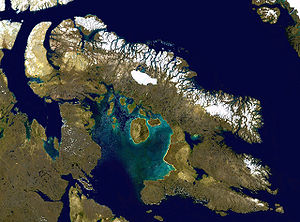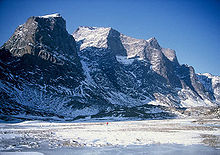Baffin Island
| Baffin Island (Qikiqtaaluk) Baffin Island, Baffinland |
|
|---|---|
| Satellite image of the island | |
| bodies of water |
Arctic Ocean Atlantic Ocean |
| Geographical location | 69° N , 72° W |
| length | 1 600 km |
| broad | 700 km |
| surface | 507,451 km² |
| highest elevation |
Mount Odin 2147 m |
| resident | 11,855 (10 May 2011) <1 inh/km² |
| main place | Iqaluit |
|
Northeast coast of Baffin Island from 11,500 meters |
|
Baffin Island , also known as Baffinland , ( English Baffin Island , Inuktitut Qikiqtaaluk ) is the largest island in the Canadian Arctic Archipelago . With an area of 507,451 km², around 1600 km in length and between 200 and 700 km in width, it is the fifth largest island on earth.
Topographic Description

Baffin Island, part of the Canadian Territory of Nunavut , is located north of the province of Quebec and west of Greenland . The closest distance to mainland Canada is across from the Melville Peninsula , from which Baffin Island is separated only by the narrow Fury and Hecla Strait , which is about 2 km wide at its narrowest point.
The north-east side of the island is predominantly mountainous ( Baffin Mountains , part of the Arctic Cordillera ) and heavily glaciated . To the southeast, the Penny Ice Cap , a relic of the last ice age and part of Auyuittuq National Park , rises to almost 2100 m . The West and Northwest consist of glacially-formed lowlands with the typical eroded crags of the Canadian Shield and are covered by glacial debris flats and tundras .
Baffin Island is very rugged and shows an unmistakable outline with its numerous bays, inlets, fjords and peninsulas: In the north, the Brodeur Peninsula is defined by an elongated inlet, formed by Admiralty Inlet with the adjoining Berlinguet Inlet, on the one hand and a sea bay penetrating deep into the interior of the island , the Bernier Bay, on the other hand almost completely separated from the actual island. The mountainous southeast coast is characterized by numerous fjords . To the southwest, a similar narrow land bridge leads to Foxe Peninsula , and to the south, the Meta Incognita Peninsula is formed by Frobisher Bay . The broad and deep-cut Cumberland Sound and Nettilling Lake also form an isthmus in the southern center of the island, which lies on the Arctic Circle .
residents
Baffin Island is part of the Qikiqtaaluk (Baffin) Nunavut region . On the island itself, 13,768 people (as of May 10, 2011 census), mostly Inuit , live in six coastal Inuit settlements. Iqaluit , the capital of the Territory of Nunavut formed on April 1, 1999 , is to the southeast. Two other settlements are located on small islands immediately offshore: Cape Dorset in the south-west and Qikiqtarjuaq in the east.
The Inuit of Baffin Island are descendants of the Thule people . The north is home to the Iglulik tribe and the east coast is home to the southern Baffin Island Inuit, related to those in Labrador.
story
Baffin Island is probably what the Vikings called Helluland . It cannot be proven that they built settlements in the inhospitable country. However, it was probably a transit and trading station on the sea voyage from the western settlement of Greenland to Labrador and on to Newfoundland .
In the Tanfield Valley in southwest Baffin Island, Canadian archaeologist Patricia Sutherland found remains of European rats in 2012 , as well as whetstones with microscopic fragments of metals, yarn made from sheep's wool and other artifacts said to resemble those found by the Vikings of Greenland . She assumes that it was a Viking trading post around 1300. However, some of the objects have been radiocarbon dated to earlier centuries; they could have gotten there as part of earlier trade relations. Other experts doubt the interpretation of the artifacts as a whole; they consider the place to be a settlement of Dorset culture. According to Sutherland, the Canadian Museum of Civilization in Gatineau (Quebec) also contains yarn made from sheep's wool, which was believed to be animal tendons. The US archaeologist Moreau Maxwell had previously discovered a ruined house made of stone and turf with rune-like symbols in the Tanfield Valley .
On a small island west of Iqaluit is Qaummaarviit Territorial Park , which has found around 3,000 artefacts and 20,000 whale and seal bones, as well as remains of eleven sod houses, stone rings and tents from the Thule culture period around 1200. At that time, the island was apparently permanently inhabited in all seasons.
After this period, in 1576 and 1577, the Inuit had their first contacts and conflicts in the south-east of the island with the expeditions of the Englishman Martin Frobisher , who forcibly took three Inuit – a man, a woman and their child – to England. They died shortly after arriving in England. Traces of these expeditions were found at Frobisher Bay by Charles Francis Hall in the 1860s . Sporadic trade contacts between Europeans and southern Baffin Island Inuit developed in the 18th century. After 1820, whalers also encountered the Inuit in the north of the island. The now constant contact increased the dependence on European dealers. After whaling was reduced in the 20th century, the Inuit turned to fox hunting to meet their needs through the fur trade. In the 1950s, the Inuit, some of whom were still nomadic, were forced to move to Iqaluit.
Municipalities at a glance
![]() Map with all coordinates: OSM | WikiMap
Map with all coordinates: OSM | WikiMap
| Surname | Population census May 10, 2011 |
coordinates |
|---|---|---|
| Iqaluit (Frobisher Bay) | 6,699 | 63° 44′ 55″ N , 68° 31′ 11″ W |
| Pond Inlet (Middle Matalik) | 1,549 | 72° 41′ 57″ N , 77° 57′ 53″ W |
| Pangnirtung (Panniqtuuq) | 1,425 | 66° 8′ 52″ N , 65° 41′ 58″ W |
| Cape Dorset (Kingait) 1) | 1,363 | 64° 13′ 48″ N , 76° 31′ 36″ W |
| Clyde River (Kangiqtugaapik) | 934 | 70° 28′ 26″ N , 68° 35′ 10″ W |
| Arctic Bay (Ikpiaryuk) | 823 | 73° 2′ 11″ N , 85° 9′ 9″ W |
| Qikiqtarjuaq (Broughton Island) 1) | 520 | 67° 33′ 29″ N , 64° 1′ 29″ W |
| Kimmirut (Lake Harbour) | 455 | 62°50′53″ N , 69°52′28″ W |
1) Strictly speaking, the settlements of Cape Dorset and Qikiqtarjuaq are not on Baffin Island itself, but on the neighboring islands of Dorset Island and Broughton Island near the coast . Taking this into account, the total population of Baffin Island (as of the May 10, 2011 census) is not 13,768, but only 11,855.
fauna
Baffin Island is home to a variety of arctic species, most notably the polar bear , barrenland caribou , arctic fox , arctic hare and arctic hare , as well as ermines , weasels , ground squirrels ( ground squirrels ) and lemmings .
Many marine mammals live on the coasts of the island: the bowhead whale , the white whale (beluga whale), the narwhal , various species of seals such as ringed seal , bearded seal and walrus . Arctic char are the most common fish in the fjords and bays .
During the spring and summer weeks between June and August there is a great abundance of breeding sea and land bird species, including raptors such as gyrfalcons and peregrine falcons , waterfowl such as arctic gulls , thayer gulls and northern gulls , eider ducks and Canada geese , as well as ptarmigans , spur buntings and snow buntings . Year-round are u. a. the common raven and the snowy owl can be found.
flora
Soil crumbs have formed on former glacial bases, on which, in addition to lichens and mosses , cushions of sessile campion , some saxifrages , arctic poppies and mountain avens have developed. Tufts of grass and low shrubs such as dwarf birches , willows and heathers grow in sandy corners . Almost all of the Arctic flora and some rare plant species, such as a white-flowered subspecies of the dwarf willowherb , thrive on the bays with their usual tundra soils and along the coastlines ; In Auyuittuq National Park alone , 112 species of higher flowering plants, 129 species of moss and 97 different lichens have been cataloged to date.
natural resources
Deposits of lead and zinc were discovered in the north of Baffin Island ( Nanisivik mining settlement ; now abandoned).
tourism
Ski, snowmobile, climbing, and boating tourism are beginning to take hold on Baffin Island. Since 2005, the Alianait Arts Festival has been held in Iqaluit annually at the end of June with international and local participation. It is primarily used to present Inuit music and art and is advertised as an alcohol-free and family-friendly festival.
literature
- Franz Boas : Baffin country. Geographical results of a research trip carried out in the years 1883 and 1884 . Perthes, Gotha 1885.
- Bernhard Hantzsch : The crossing of Baffin Island to Foxe Basin (English translation by MBA Anderson), Appendix in: AE Millward Southern Baffin Island : an account of exploration, investigation and settlement during the past fifty years . FA Acland, Ottawa 1930.
- Bernhard Hantzsch: My life among the Eskimos. Baffinland journeys in the years 1909 to 1911 (English translation by Leslie H. Neatby), University of Saskatchewan , Saskatoon 1977.
- Miriam Dewar (ed.): The Nunavut Handbook. Traveling in Canada's Arctic . Ayaya, Iqaluit /Ottawa 2004, ISBN 0-9736754-0-3
web links
- Visitors Guide to Baffins Island
itemizations
- ↑ Moreau S. Maxwell: Prehistory of the eastern Arctic. Orlando FL 1985.
- ↑ Andrew Hamilton, The Medieval Norse on Baffin Island. In: Countercurrents Publishing, 2013.
- ↑ Renee Fosset: In Order to Live Untroubled: Inuit of the Central Arctic 1550-1940. university of Manitoba Press, 2001.
- ↑ Baffin Island Inuit ( English, French ) In: The Canadian Encyclopedia . Retrieved July 28, 2019.
- ↑ Festival information 2019 on alianait.ca








